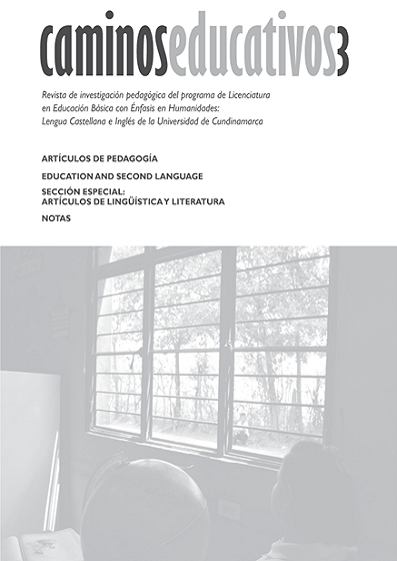USING WORKING MEMORY AND DEVELOPING CRITICAL THINKING IN THE REFLECTIVE LEARNING AND TEACHING PROCESSES
DOI:
https://doi.org/10.36436/22564527.86Keywords:
Learning process, working memory, critical thinking, experiential learning, peer observation, programming units, physical response, transition to behavior.Abstract
This paper attempts to provide reflection upon day to day teaching exercise andproposes a methodological procedure to engage students thru working memoryand critical thinking development in the target language during the learning process.It suggests a procedural method consisting on Programming Units, PhysicalResponses, and Transition to Behavior (PURF, TPR & T2B) to meet Bloom´s taxonomyaccordingly. It also refers to the role of the EFL teacher as a facilitator whouses a wide variety of resources including technology; similarly the active role ofthe learner framed within experiential learning theory is mentioned.Downloads
References
EDEN Conference, Bologna,(1998). The role of university teachers inadigital era. Online at:
http://www.eurodl.org/materials/contrib/1998/eden98/Ljosa.html
• Karl E. Weick, (1993). Collective Mindin Organizations: Heed fulI Interrelating on Flight Decks.
University of Michigan. Online at: http://www.lse.ac.uk/study/executiveEducation/customisedExecutiveEducation/
INAP/Collectivemionnd.pdf1.1.1
• B.D. Hill, (et.al). (2010). Can we improve the clinical assessment of working memory? An eva -
luation of the Wechsler Adult Intelligence Scale-Third Edition using a working memory criterion
construct. Volume32,Issue3,2010.Onlineat:http://www.tandfonline.com/doi/full/10.1080/
#abstract
• 1.1.2 Doolittle, Peter.(2013)Howyour“workingmemory”makessenseoftheworldatTED
Talks, available at: www.ted.com/talks/peter_doolittle_how_your_working_memory_makes_
sense_of_the_world
• Saussure,Ferdinandde.(1857-1913).CourseingeneralLinguistics(1959).Onlineat:https://
archive.org/details/courseingenerall00saus
• Wilson,K.(et.al). (2003).Teachers’UseofTechnology:LessonsLearnedfromtheTeacherEdu -
cationProgramtotheClassroom.UniversityofAlabama.Onlineat:http://files.eric.ed.gov/full -
text/EJ959529.pdf
Rogers, A. (1996). Teaching Adults (2nd ed.). Buckingham: Open University Press. Online at:
https://books.google.co.za/books/about/Teaching_adults.html?id=GQJPAAAAYAAJ
• Cottrell, S. 2011, Critical thinking skills: developing effective analysis and argument, 2nd edn,
Palgrave MacMillan, Hampshire, UK. Online at: http://ebookall.biz/pdf/title/Stella-Cottrell-Critical
T Tinking-Skills-.html
• Bloom, Benjamin (1956): Taxonomy of Educational Objectives (1956). Published by Allyn and
Bacon, Boston, MA. Online at: http://www.eduteka.org/TaxonomiaBloomCuadro.php3http://
www.utar.edu.my/fegt/file/Revised_Blooms_Info.pdf
• Fowler, Richard (2012):
• Colin, Beard. (2010). The Experiential Learning Toolkit. Blending Practices with Concepts. Library
of Congress. Online at: http://es.scribd.com/doc/55041027/The-Experiential-Learning-Toolkit-
Blending -Practice-With-Concepts-0749450789
• Baddeley, A.D. & Hitch, G.J. (1974). Working memory. In G.A. Bower (Ed.), The psychology of
learning and motivation, Vol. 8 (pp. 47–89). New York: Academic Press. Online at:http://www.
sagepub.com/sites/default/files/upm-binaries/42874_Henry.pdf
• Baddeley, A.D. (2001). The episodic buffer: a new component of working memory? Online at:
http://old.nbu.bg/cogs/events/2002/materials/Markus/ep_bufer.pdf
• Ong, W. (1982). Orality and Literacy. Methuen and Company. Online at: https://en.wikibooks
org/wiki/Communication_Theory/Orality_and_Literacy
• Unsworth, N. (et.al) (2007). Examining the relations among working memory capacity, atten
tion control, and fluid intelligence from a dual-component framework. In Psychology Science
Quarterly, Volume 51, 2009 (4), pp. 388-402. Online at: http://maidlab.uoregon.edu/PDFs/
UnsworthSpillers&Brewer(2009)PSQ.pdf
• Asher, J. (1969). The Total Physical Response Approach to Second Language Learning” in The
Modern Language Journal, Vol. 53, No.1. Online at: http://www.tpr-world.com/http://
www.tprsource.com/asher.htm
• Sebeok, Thomas (2001) Sign: an introduction to semiotics, University of Toronto, 2nd edition.
Online at: http://monoskop.org/images/0/07/Sebeok_Thomas_Signs_An_Introduction_to_
Semiocs_2nd_ed_2001.pdf



